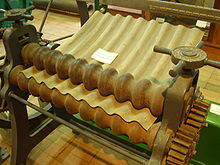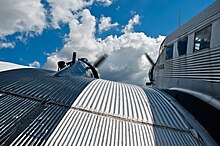Corrugated iron
As corrugated iron is referred to a plate made of sheet metal , by their wave-shaped cross-section even at a low strength of the sheet, a high stiffness and load-bearing capacity attained.
Manufacturing
Corrugated iron is usually made of hot-dip galvanized steel. Coating with a zinc - aluminum alloy ( Galvalume ) is less common . The corrugated metal sheet can either be straight or bent into a cylindrical surface. The first corrugated metal sheets produced had only a small wave height . Today, trapezoidal sheets are manufactured with a web height of 20 cm and a sheet thickness of only 0.5 mm. The production takes place mainly by roll profiling or broadband profiling .
history
Henry Robinson Palmer , an engineer at the London Docks , is considered an inventor and patented corrugated iron in 1829. After the patent expired in 1843, corrugated iron became an important building material used worldwide. It has been used for roofing in England since the 1850s . During the settlement of the western USA and from 1900 in Australia and New Zealand, corrugated iron was used for the rapid establishment of new settlements.
The Barmer Industrial Carl Ludwig Wesenfeld created the conditions for worldwide dissemination and application of corrugated iron, both as a building material and mechanical engineering by "established the actual carrier corrugated iron where the wave height is greater than half the width of wave" 1875th
use
Corrugated iron is mainly used as weather protection for space-enclosing components, most often as roofing . Corrugated and trapezoidal sheets are widely used in industrial buildings as well as in temporary or improvised buildings, for example in slums . The French word for slum, Bidonville , comes from the French bidon , tin canister .
Vehicles and aircraft were also made of corrugated iron. The Junkers Ju 52 / 3m with its fuselage and wings made of sheet aluminum is particularly well known . The van Citroen type H and the first version of the 2CV (duck) were partially of crimped , corrugated sheet-like profiled metal sheets.
During the First World War , mobile corrugated iron buildings (" Nissen huts ") were used, which are now also known as arched halls. They require little space, are easy to erect in comparison to halls made of trapezoidal sheet metal (depending on snow and wind loads ) and as mobile buildings do not necessarily require a building permit .

See also
Web links
Individual evidence
- ^ List of patents granted at London in 1829. In: Polytechnisches Journal . 32, 1829, Miszelle 1, pp. 446-447.
- ^ History of Corrugated Metal Roofing
- ^ A b History of Corrugated Iron
- ↑ Ernst Walter Röhrig: On the history of the Wesenfeld family . Volume I., Barmen 1929, p. 74
- ↑ Ludwig Darmstaedter: Handbook on the history of natural sciences and technology. In chronological representation. 2nd, revised and enlarged edition. Singer, Berlin 1908, p. 735, ( Textarchiv - Internet Archive )
- ^ Francis Nenik: XO . (PDF) Roman, esp.p. 567ff.



